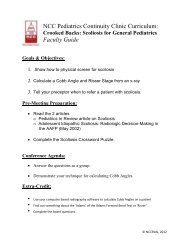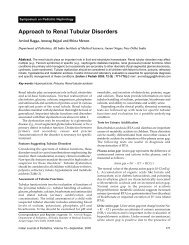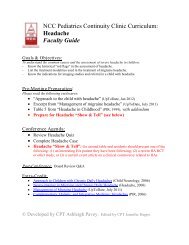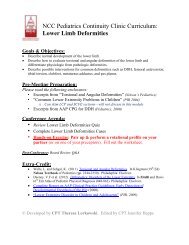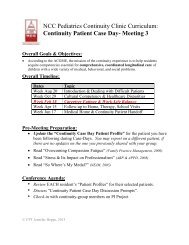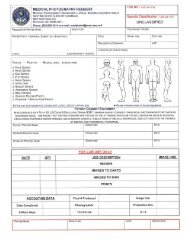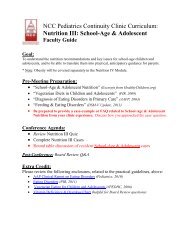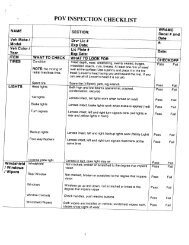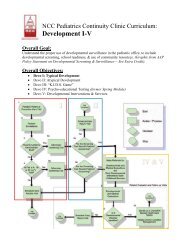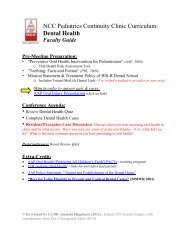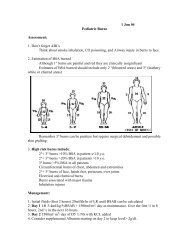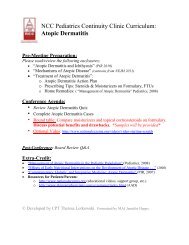NOMLL - NAVAL OPERATIONAL MEDICAL LESSONS LEARNED
NOMLL - NAVAL OPERATIONAL MEDICAL LESSONS LEARNED
NOMLL - NAVAL OPERATIONAL MEDICAL LESSONS LEARNED
You also want an ePaper? Increase the reach of your titles
YUMPU automatically turns print PDFs into web optimized ePapers that Google loves.
N U M B E R 2<br />
Optimal Fluid Resuscitation for Severely<br />
Injured Casualties<br />
P A G E 3<br />
In his letter of 3 January 2007, LTG Kevin Kiley, the Surgeon General of<br />
the Army, forwarded important new information on the resuscitation of<br />
severely injured casualties. The U.S. Army Institute of Surgical Research<br />
(USAISR) has found that increasing the ratio of FreshFrozen Plasma<br />
(FFP) to Packed Red Blood Cells (PRBCs) administered can dramatically<br />
increase the survival rate of casualties who require massive transfusions.<br />
“Massive transfusion” is defined as 10 units or more of PRBCs in a 24<br />
hour period. USAISR’s analysis of data from OIF/OEF found that casualties<br />
meeting this criteria who received FFP in a ratio of 1:1 with PRBCs<br />
had a mortality of 20%; in contrast, casualties in ths group who received<br />
FFP at a ratio of 1 unit of FFP to 4 units of PRBCs or less had a mortality<br />
of 65%.<br />
Click here to read more…..<br />
Mountain Medicine Topical Site<br />
The U.S. Marine Corps Center for Lessons Learned issued a Quick<br />
Look report on 21 December 2006 noting that current operations in<br />
Afghanistan entail extensive deployment of forces to mountainous<br />
regions of that country. This report highlighted the need for additional<br />
information and training on mountain operations. The Navy Operational<br />
Medical Lessons Learned Center has responded with a new<br />
Topical Site called Mountain Medicine. Among the items included in<br />
this topical site are:<br />
High Altitude Warfare: The Kargil Conflict and the Future of<br />
Mountain Warfare<br />
(U.S. Naval Postgraduate School thesis paper by Marcus P. Acosta)<br />
Summary The emergence of precision warfare has altered the nature<br />
of warfare on most of the world’s surface, yet has not significantly<br />
changed the conduct of ground combat at high altitude. This thesis<br />
examines the impact of the high altitude environment on soldiers,<br />
their weapons, and military operations.<br />
Medical Aspects of Harsh Environments Volume Two<br />
This chapter is excerpted from the U.S. Army Textbook of Military Medicine.<br />
Summary – This volume of the Military Medicine textbook series published by the Office of the Army Surgeon General<br />
contains a comprehensive review of the medical and physiological issues entailed in military operations in mountain terrain.<br />
USSOCOM Tactical Medical Emergency Protocols with Approval Letter<br />
Summary First responders operating in austere environment may be required to treat patients with nontraumatic medical<br />
conditions for extended periods of time. These protocols, developed by the US Special Operations Command and<br />
approved by the Commander in May 2005, provide a diagnostic and management approach suitable for use by combat<br />
medical personnel in the austere environment for 41 medical disorders.<br />
Staging Protocols for Inducing Altitude Acclimatization<br />
Summary An important aspect of operations in mountainous terrain is the prevention, recognition, and treatment of altituderelated<br />
diseases. One critical aspect of physiological acclimatization to altitude is covered in an information paper<br />
produced by the U.S. Army Research Institute of Environmental Medicine dated 18 September 2001. For personnel ascending<br />
from low altitude (



